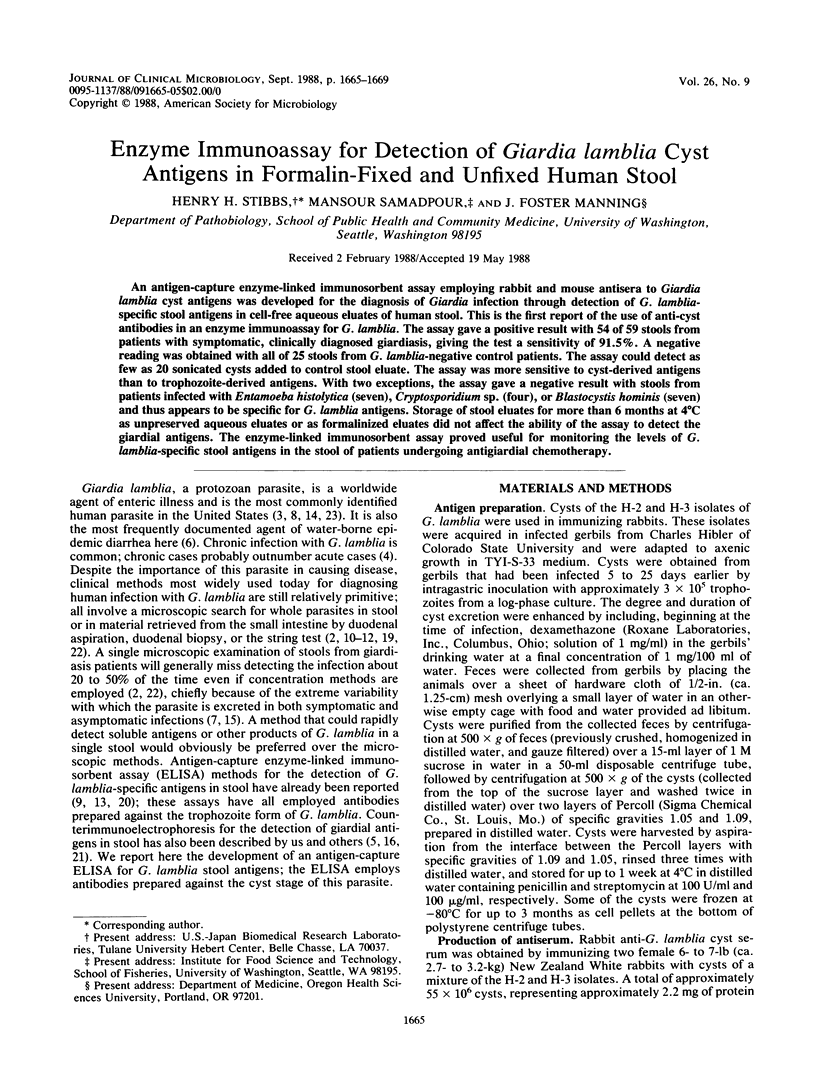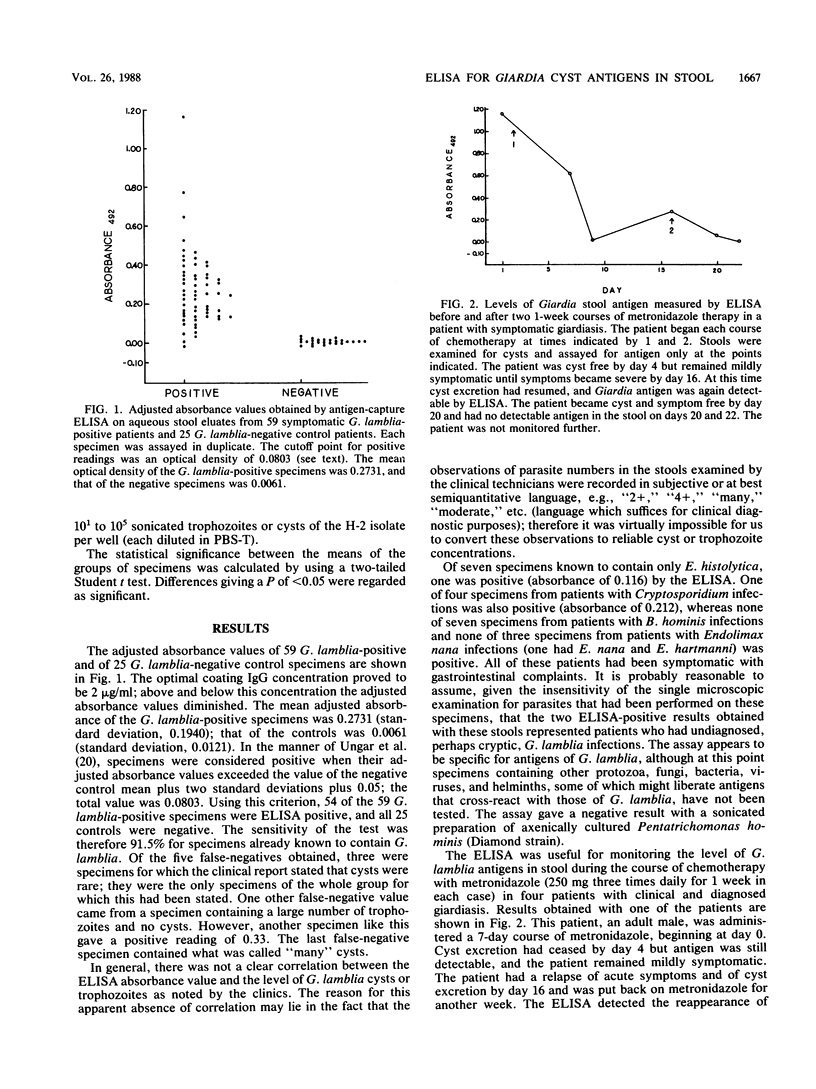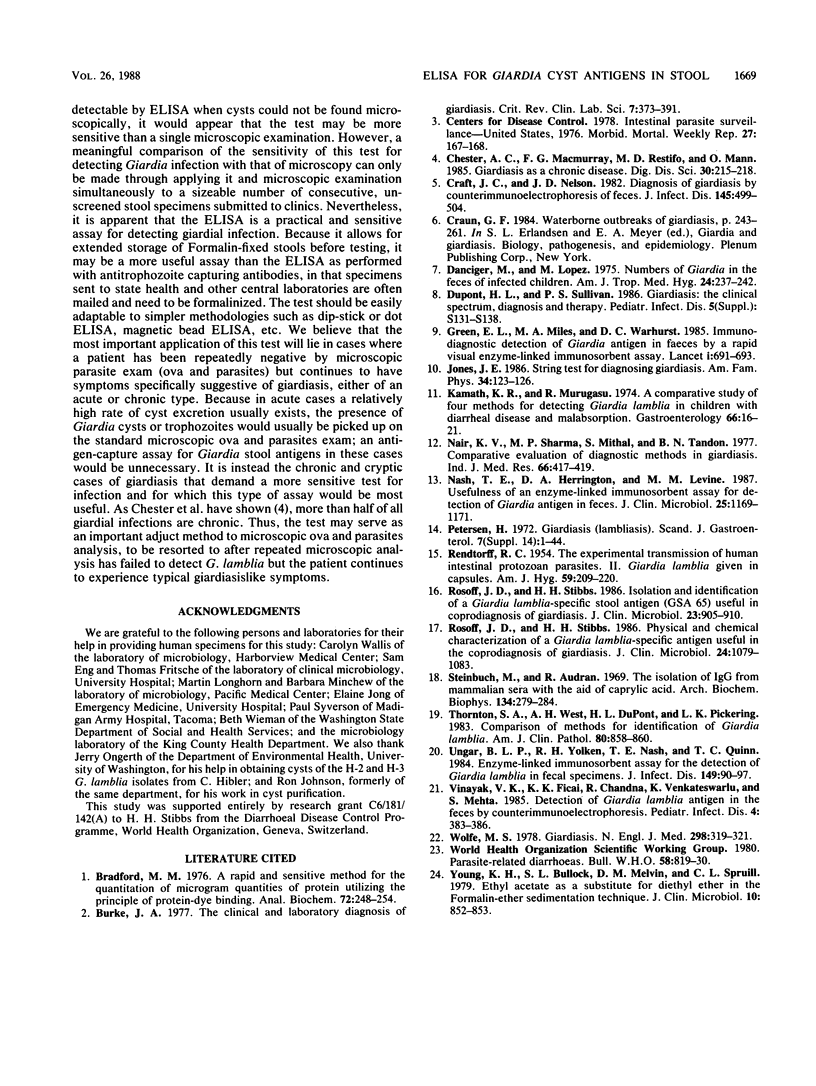Abstract
An antigen-capture enzyme-linked immunosorbent assay employing rabbit and mouse antisera to Giardia lamblia cyst antigens was developed for the diagnosis of Giardia infection through detection of G. lamblia-specific stool antigens in cell-free aqueous eluates of human stool. This is the first report of the use of anti-cyst antibodies in an enzyme immunoassay for G. lamblia. The assay gave a positive result with 54 of 59 stools from patients with symptomatic, clinically diagnosed giardiasis, giving the test a sensitivity of 91.5%. A negative reading was obtained with all of 25 stools from G. lamblia-negative control patients. The assay could detect as few as 20 sonicated cysts added to control stool eluate. The assay was more sensitive to cyst-derived antigens than to trophozoite-derived antigens. With two exceptions, the assay gave a negative result with stools from patients infected with Entamoeba histolytica (seven), Cryptosporidium sp. (four), or Blastocystis hominis (seven) and thus appears to be specific for G. lamblia antigens. Storage of stool eluates for more than 6 months at 4 degrees C as unpreserved aqueous eluates or as formalinized eluates did not affect the ability of the assay to detect the giardial antigens. The enzyme-linked immunosorbent assay proved useful for monitoring the levels of G. lamblia-specific stool antigens in the stool of patients undergoing antigiardial chemotherapy.
Full text
PDF




Selected References
These references are in PubMed. This may not be the complete list of references from this article.
- Bradford M. M. A rapid and sensitive method for the quantitation of microgram quantities of protein utilizing the principle of protein-dye binding. Anal Biochem. 1976 May 7;72:248–254. doi: 10.1016/0003-2697(76)90527-3. [DOI] [PubMed] [Google Scholar]
- Burke J. A. The clinical and laboratory diagnosis of giardiasis. CRC Crit Rev Clin Lab Sci. 1977 Jun;7(4):373–391. doi: 10.3109/10408367709151690. [DOI] [PubMed] [Google Scholar]
- Chester A. C., MacMurray F. G., Restifo M. D., Mann O. Giardiasis as a chronic disease. Dig Dis Sci. 1985 Mar;30(3):215–218. doi: 10.1007/BF01347886. [DOI] [PubMed] [Google Scholar]
- Craft J. C., Nelson J. D. Diagnosis of giardiasis by counterimmunoelectrophoresis of feces. J Infect Dis. 1982 Apr;145(4):499–504. doi: 10.1093/infdis/145.4.499. [DOI] [PubMed] [Google Scholar]
- Danciger M., Lopez M. Numbers of Giardia in the feces of infected children. Am J Trop Med Hyg. 1975 Mar;24(2):237–242. doi: 10.4269/ajtmh.1975.24.237. [DOI] [PubMed] [Google Scholar]
- Dupont H. L., Sullivan P. S. Giardiasis: the clinical spectrum, diagnosis and therapy. Pediatr Infect Dis. 1986 Jan-Feb;5(1 Suppl):S131–S138. [PubMed] [Google Scholar]
- Green E. L., Miles M. A., Warhurst D. C. Immunodiagnostic detection of Giardia antigen in faeces by a rapid visual enzyme-linked immunosorbent assay. Lancet. 1985 Sep 28;2(8457):691–693. doi: 10.1016/s0140-6736(85)92932-0. [DOI] [PubMed] [Google Scholar]
- Jones J. E. String test for diagnosing giardiasis. Am Fam Physician. 1986 Aug;34(2):123–126. [PubMed] [Google Scholar]
- Kamath K. R., Murugasu R. A comparative study of four methods for detecting Giardia lamblia in children with diarrheal disease and malabsorption. Gastroenterology. 1974 Jan;66(1):16–21. [PubMed] [Google Scholar]
- Nair K. V., Sharma M. P., Mithal S., Tandon B. N. Comparative evaluation of diagnostic methods in giardiasis. Indian J Med Res. 1977 Sep;66(3):417–419. [PubMed] [Google Scholar]
- Nash T. E., Herrington D. A., Levine M. M. Usefulness of an enzyme-linked immunosorbent assay for detection of Giardia antigen in feces. J Clin Microbiol. 1987 Jul;25(7):1169–1171. doi: 10.1128/jcm.25.7.1169-1171.1987. [DOI] [PMC free article] [PubMed] [Google Scholar]
- Petersen H. Giardiasis (lambliasis). Scand J Gastroenterol Suppl. 1972;14:1–44. [PubMed] [Google Scholar]
- RENDTORFF R. C. The experimental transmission of human intestinal protozoan parasites. II. Giardia lamblia cysts given in capsules. Am J Hyg. 1954 Mar;59(2):209–220. doi: 10.1093/oxfordjournals.aje.a119634. [DOI] [PubMed] [Google Scholar]
- Rosoff J. D., Stibbs H. H. Isolation and identification of a Giardia lamblia-specific stool antigen (GSA 65) useful in coprodiagnosis of giardiasis. J Clin Microbiol. 1986 May;23(5):905–910. doi: 10.1128/jcm.23.5.905-910.1986. [DOI] [PMC free article] [PubMed] [Google Scholar]
- Rosoff J. D., Stibbs H. H. Physical and chemical characterization of a Giardia lamblia-specific antigen useful in the coprodiagnosis of giardiasis. J Clin Microbiol. 1986 Dec;24(6):1079–1083. doi: 10.1128/jcm.24.6.1079-1083.1986. [DOI] [PMC free article] [PubMed] [Google Scholar]
- Steinbuch M., Audran R. The isolation of IgG from mammalian sera with the aid of caprylic acid. Arch Biochem Biophys. 1969 Nov;134(2):279–284. doi: 10.1016/0003-9861(69)90285-9. [DOI] [PubMed] [Google Scholar]
- Thornton S. A., West A. H., DuPont H. L., Pickering L. K. Comparison of methods for identification of Giardia lamblia. Am J Clin Pathol. 1983 Dec;80(6):858–860. doi: 10.1093/ajcp/80.6.858. [DOI] [PubMed] [Google Scholar]
- Ungar B. L., Yolken R. H., Nash T. E., Quinn T. C. Enzyme-linked immunosorbent assay for the detection of Giardia lamblia in fecal specimens. J Infect Dis. 1984 Jan;149(1):90–97. doi: 10.1093/infdis/149.1.90. [DOI] [PubMed] [Google Scholar]
- Vinayak V. K., Kum K., Chandna R., Venkateswarlu K., Mehta S. Detection of Giardia lamblia antigen in the feces by counterimmunoelectrophoresis. Pediatr Infect Dis. 1985 Jul-Aug;4(4):383–386. doi: 10.1097/00006454-198507000-00010. [DOI] [PubMed] [Google Scholar]
- Wolfe M. S. Giardiasis. N Engl J Med. 1978 Feb 9;298(6):319–321. doi: 10.1056/NEJM197802092980606. [DOI] [PubMed] [Google Scholar]
- Young K. H., Bullock S. L., Melvin D. M., Spruill C. L. Ethyl acetate as a substitute for diethyl ether in the formalin-ether sedimentation technique. J Clin Microbiol. 1979 Dec;10(6):852–853. doi: 10.1128/jcm.10.6.852-853.1979. [DOI] [PMC free article] [PubMed] [Google Scholar]


